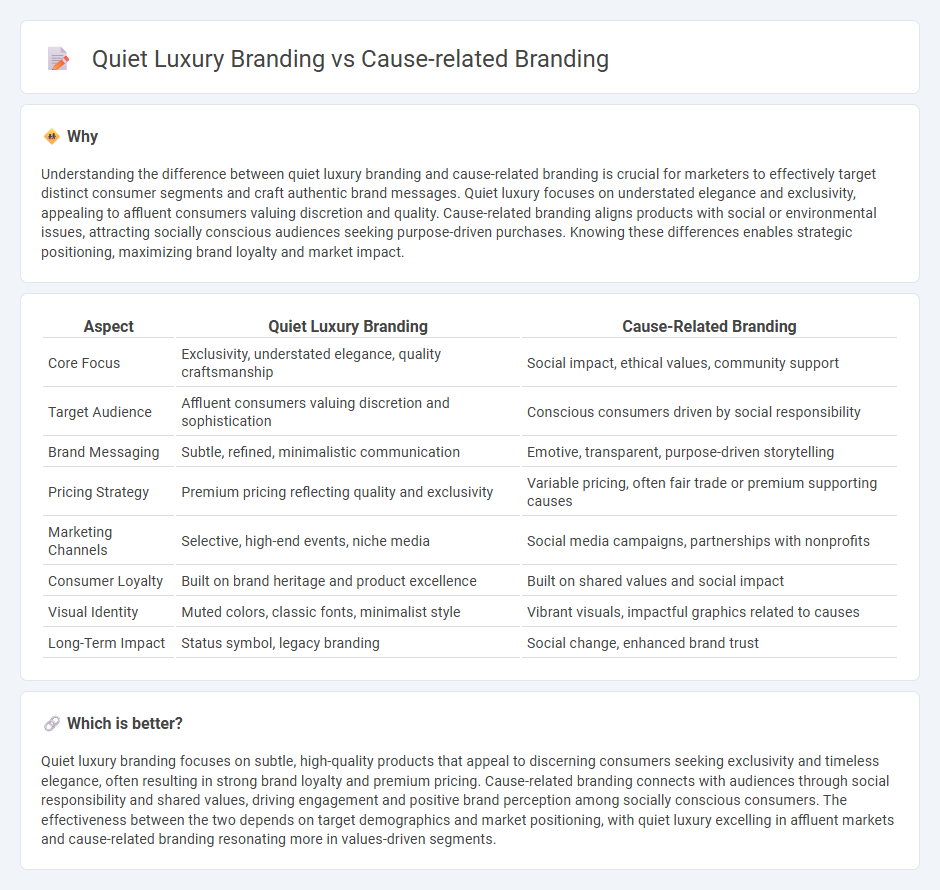
Quiet luxury branding emphasizes subtle elegance, high-quality materials, and timeless design to attract discerning consumers seeking understated sophistication. Cause-related branding leverages social, environmental, or ethical commitments to build emotional connections and foster brand loyalty among socially conscious buyers. Explore how these distinct marketing strategies shape consumer engagement and brand perception.
Why it is important
Understanding the difference between quiet luxury branding and cause-related branding is crucial for marketers to effectively target distinct consumer segments and craft authentic brand messages. Quiet luxury focuses on understated elegance and exclusivity, appealing to affluent consumers valuing discretion and quality. Cause-related branding aligns products with social or environmental issues, attracting socially conscious audiences seeking purpose-driven purchases. Knowing these differences enables strategic positioning, maximizing brand loyalty and market impact.
Comparison Table
| Aspect | Quiet Luxury Branding | Cause-Related Branding |
|---|---|---|
| Core Focus | Exclusivity, understated elegance, quality craftsmanship | Social impact, ethical values, community support |
| Target Audience | Affluent consumers valuing discretion and sophistication | Conscious consumers driven by social responsibility |
| Brand Messaging | Subtle, refined, minimalistic communication | Emotive, transparent, purpose-driven storytelling |
| Pricing Strategy | Premium pricing reflecting quality and exclusivity | Variable pricing, often fair trade or premium supporting causes |
| Marketing Channels | Selective, high-end events, niche media | Social media campaigns, partnerships with nonprofits |
| Consumer Loyalty | Built on brand heritage and product excellence | Built on shared values and social impact |
| Visual Identity | Muted colors, classic fonts, minimalist style | Vibrant visuals, impactful graphics related to causes |
| Long-Term Impact | Status symbol, legacy branding | Social change, enhanced brand trust |
Which is better?
Quiet luxury branding focuses on subtle, high-quality products that appeal to discerning consumers seeking exclusivity and timeless elegance, often resulting in strong brand loyalty and premium pricing. Cause-related branding connects with audiences through social responsibility and shared values, driving engagement and positive brand perception among socially conscious consumers. The effectiveness between the two depends on target demographics and market positioning, with quiet luxury excelling in affluent markets and cause-related branding resonating more in values-driven segments.
Connection
Quiet luxury branding and cause-related branding connect through their emphasis on authentic storytelling and subtle value communication that resonates deeply with discerning consumers. Both strategies foster strong emotional bonds by aligning brand identity with meaningful social causes or refined exclusivity, enhancing consumer loyalty and perceived brand integrity. This synergy elevates brand equity by integrating sustainable luxury aesthetics with purpose-driven narratives, appealing to ethically-minded, high-net-worth audiences.
Key Terms
Social Impact vs. Exclusivity
Cause-related branding emphasizes social impact by aligning products and campaigns with philanthropic efforts, fostering consumer trust and loyalty through shared values. Quiet luxury branding centers on exclusivity and understated elegance, appealing to affluent consumers who seek discreet sophistication without overt logos or flashy designs. Explore deeper insights to understand how each strategy uniquely influences brand perception and market positioning.
Purpose-driven Messaging vs. Discreet Status
Cause-related branding emphasizes authentic purpose-driven messaging that connects deeply with socially conscious consumers seeking brands aligned with their values. Quiet luxury branding focuses on discreet status signals through high-quality craftsmanship, timeless design, and exclusivity without overt logos or promotional messaging. Explore how these distinct strategies shape consumer perception and brand loyalty in luxury and ethical markets.
Brand Activism vs. Understated Elegance
Cause-related branding emphasizes brand activism by aligning products and marketing with social or environmental causes to build consumer trust and loyalty. Quiet luxury branding prioritizes understated elegance, offering high-quality, discreet products that appeal to consumers seeking timeless sophistication without overt logos or flashy designs. Discover more about how these distinct branding strategies shape consumer perceptions and market positioning.
Source and External Links
What Is Cause Related Marketing And How Does It Benefit ... - Cause-related branding is a partnership between a business and a nonprofit, allowing the business to promote a social or environmental cause while enhancing its own reputation and bottom line.
6 Powerful Examples of Cause-Related Marketing - Cause-related branding focuses on marketing a specific cause or idea, rather than just a product, to build consumer engagement and positive brand perception.
Cause marketing: Examples from Uber, Starbucks & JetBlue - Cause-related branding typically involves collaborations between for-profit companies and nonprofits to raise awareness or funds for a shared social or environmental goal.
 dowidth.com
dowidth.com